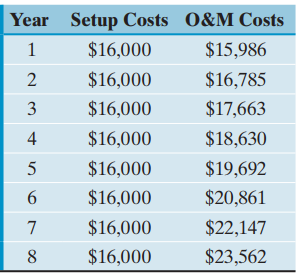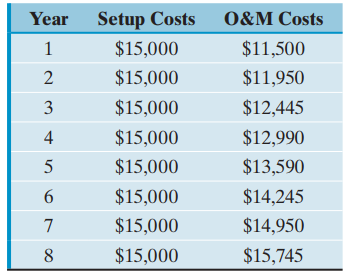Rivera Industries, a manufacturer of home-heating appliances, is considering the purchase of a used Amada turret punch
Question:
The four presses in use now were purchased six years ago at a price of $100,000. The manufacturing engineer expects that these machines can be used for eight more years, but they will have no market value after that. These presses have been depreciated by the MACRS method (seven-year property).
The current book value is $13,387, and the present market value is estimated to be $40,000. The average setup cost, which is determined by the number of required labor hours times the labor rate for the old presses, is $80 per hour, and the number of setups per year expected by the production control department is 200. These conditions yield a yearly setup cost of $16,000. The expected operating and maintenance costs for each year in the remaining life of this system are estimated as follows:
These costs, which were estimated by the manufacturing engineer with the aid of data provided by the vendor, represent a reduction in efficiency and an increase in needed service and repair over time.
The price of the two-year-old Amada turret punch press is $135,000 and would be paid for with cash from the company€™s capital fund. In addition, the company would incur installation costs totaling $1,200. Also, an expenditure of $12,000 would be required in order to recondition the press to its original condition. The reconditioning would extend the Amada€™s economic service life to eight years. It would have no salvage value at the end of that time. The Amada would be depreciated under the MACRS with the half-year convention as a seven-year property. The average setup cost of the Amada is $15, and it would require 1,000 setups per year, yielding a yearly setup cost of $15,000. Rivera€™s accounting department has estimated that at least $26,000, and probably $36,000, per year could be saved by shortening production runs and thus, carrying costs. The operating and maintenance costs of the Amada as estimated by the manufacturing engineer are similar to, but somewhat less than, the O&M costs for the present system:

The reduction in the O&M costs is caused by the age difference of the machines and the reduced power requirements of the Amada. If Rivera Industries delays the replacement of the current four presses for another year, the secondhand Amada machine will no longer be available, and the company will have to buy a brand-new machine at an installed price of $200,450. Its expected setup costs would be the same as those for the secondhand machine, but the annual O&M costs of the new one would be about 10% lower than the estimated O&M costs for the secondhand machine. The expected economic service life of the brand-new press would be eight years with no salvage value at the end of that period. The brand-new press also falls into a seven-year MACRS property class. Rivera€™s MARR is 12% after taxes, and the marginal income-tax rate is expected to be 40% over the life of the project.
(a) Assuming that the company would need the service of either the Amada press or the current presses for an indefinite period, which option would you recommend?
(b) Assuming that the company would need the press system for only five more years, which option would you recommend?
Salvage value is the estimated book value of an asset after depreciation is complete, based on what a company expects to receive in exchange for the asset at the end of its useful life. As such, an asset’s estimated salvage value is an important... MARR
Minimum Acceptable Rate of Return (MARR), or hurdle rate is the minimum rate of return on a project a manager or company is willing to accept before starting a project, given its risk and the opportunity cost of forgoing other...
Step by Step Answer:






